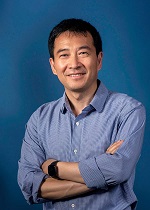Eliminating Drug-Resistant Bacteria and Fungal Infections via Photo-Inactivation of Intrinsic Chromo
This webinar is hosted By: Therapeutic Laser Applications Technical Group
28 October 2022 12:00 - 13:00
Eastern Daylight/Summer Time (US & Canada) (UTC -04:00)Antibiotic resistance kills an estimated 700,000 people each year worldwide, and studies predict that this number could rise to 10 million by 2050 if efforts are not made to curtail resistance (Nature, 2017, 543:15). Yet, the pace of resistance acquisition from a mutation in pathogens is faster than the clinical introduction of new antibiotics. This severe situation calls for an urgent need of developing unconventional ways to combat the resistance.
To tackle this challenge, Ji-Xin Cheng is developing a novel phototherapy platform for fighting against a broad spectrum of drug-resistant infections including MRSA and Candida auris. In particular, Dr. Cheng has found that many intrinsic chromophores are prone to photobleaching through one-photon and even two-photon absorption. Importantly, these chromophores are virulence factors or essential for bacteria to survive in a stressed condition. Thus, photo-destruction of these intrinsic chromophores sensitizes the bacteria to attack by ROS or conventional antibiotics. Unlike photodynamic therapy, this approach is agent free.
Subject Matter Level: Introductory - Assumes little previous knowledge of the topic
What You Will Learn:
• Use of light to eliminate drug-resistant bacteria and fungal infections
Who Should Attend:
• Scientists, researchers, and professors
• Postdoctoral fellows
• Graduate and undergraduate students
About the Presenter: Ji-Xin Cheng from Boston University
 Ji-Xin Cheng attended University of Science and Technology of China (USTC) from 1989 to 1994. From 1994 to 1998, he carried out his PhD study on bond-selective chemistry at USTC. As a graduate student, Cheng worked as a research assistant at Universite Paris-sud (France) on vibrational spectroscopy and the Hong Kong University of Science and Technology (HKUST) on quantum dynamics theory. After postdoctoral training on ultrafast spectroscopy at HKUST, Cheng joined Sunney Xie’s group at Harvard University as a postdoc, where he spearheaded the development of CARS microscopy that allows high-speed vibrational imaging. Cheng joined Purdue University in 2003 as Assistant Professor in Weldon School of Biomedical Engineering and Department of Chemistry, promoted to Associate Professor in 2009 and Full Professor in 2013. He joined Boston University as the Inaugural Theodore Moustakas Chair Professor in Photonics and Optoelectronics in summer 2017.
Ji-Xin Cheng attended University of Science and Technology of China (USTC) from 1989 to 1994. From 1994 to 1998, he carried out his PhD study on bond-selective chemistry at USTC. As a graduate student, Cheng worked as a research assistant at Universite Paris-sud (France) on vibrational spectroscopy and the Hong Kong University of Science and Technology (HKUST) on quantum dynamics theory. After postdoctoral training on ultrafast spectroscopy at HKUST, Cheng joined Sunney Xie’s group at Harvard University as a postdoc, where he spearheaded the development of CARS microscopy that allows high-speed vibrational imaging. Cheng joined Purdue University in 2003 as Assistant Professor in Weldon School of Biomedical Engineering and Department of Chemistry, promoted to Associate Professor in 2009 and Full Professor in 2013. He joined Boston University as the Inaugural Theodore Moustakas Chair Professor in Photonics and Optoelectronics in summer 2017.
